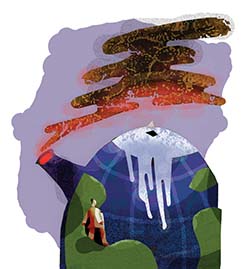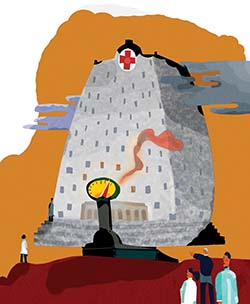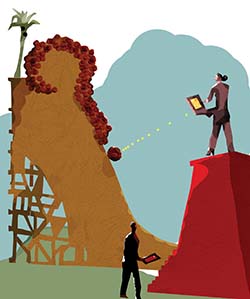 |
 |
| current issue |  | past issues |  | send a letter/news |  | address update |  | advertise |  | about us |  | alumni home |
|
Inquiring Minds By David Sims '81, David Brooks and Beth Potier Illustrations by Todd Davidson |
Easy to print version |
In this issue:
Light PlightSticker Shock
High-IQ Rocks
Light Plight
More Arctic black carbon means less snow and ice
Just as a bright white T-shirt keeps you cooler under a hot summer sun, the Arctic's highly reflective ice and snow surfaces throw solar energy back out to space. Fresh snow, in fact, reflects up to 90 percent of the sunlight that strikes it.
But as the top of the world heats up under a thickening blanket of greenhouse gases, melting ice and snow is exposing darker land and open ocean water, which reflect less sunlight, triggering a vicious cycle.

|
"The more the Arctic melts, the more it sets up this feedback cycle that further accelerates the loss," says atmospheric chemist Jack Dibb, a research associate professor at the Institute for the Study of Earth, Oceans, and Space.
This cycle is contributing to the dramatic reduction in Arctic sea ice that has been detected by satellites in recent years. A new record low was set last year.
"The greenhouse gas effect is driven by increasing levels of not only carbon dioxide but also fine particulate matter in the air—black carbon, otherwise known as soot," Dibb says.
Black carbon, from manmade sources like diesel fuel burned by ships and trucks and from naturally occurring events like forest fires, has increasingly become a focus of both scientists and environmental activists. A landmark report published in the Journal of Geophysical Research: Atmospheres in January showed for the first time that black carbon is second only to carbon dioxide as a contributor to global warming.
Because soot is short-lived—with a lifetime of just weeks compared to the century-long lifetime of carbon dioxide—activists assert that aggressive steps to reduce it could buy a little extra time in efforts to slow the pace of global warming. Much of the emphasis is on reducing the soot falling from the sky. But research Dibb has conducted at Summit Station on the Greenland ice sheet shows that airborne soot presents a bigger threat. The new report also bears this out.
When soot-laden air lingers over a highly reflective surface like an ice sheet, it absorbs some incoming light that would otherwise be reflected. This absorption warms the atmospheric layer, which then warms the surface, which in turn further reduces the amount of light reflected by snow and ice, and so on.
Meanwhile, shipping traffic in the Arctic, which is growing as the sea ice recedes, may add to the problem.
As 2012 drew to a close, the Environmental Protection Agency mandated a nationwide 20 percent reduction of fine particulates, which are linked to respiratory disease and irregular heartbeats. Dibb points out that any efforts to reduce black carbon pollution will help both planet and people.
—David Sims '81
Sticker Shock
Medical costs may have reached a tipping point
The results are still preliminary, but Les MacLeod thinks his current research into health care in New Hampshire has uncovered something surprising: Patient satisfaction doesn't necessarily increase when more money is spent on treatment. In fact, it might even decrease. "There's almost an inverse relationship," says the professor of health management and policy. The reason is not yet certain, but MacLeod has an inkling: "I suspect that hospitals that spend more tend to be bigger, busier and less personal." In this case, bigger may not always be better.
Such a counterintuitive finding may be what the nation needs to hear as it tries to cut costs while improving outcomes in health care. "We may have reached the tipping point in terms of affordability," says MacLeod, whose background includes being the CEO of hospitals in Massachusetts and New Hampshire. "People at every level are going to have to get much more serious about containing costs." Training future leaders to help us get more serious is a key point of the curriculum in UNH's health management and policy department. But none of it will be straightforward.

|
For example, MacLeod says, it's obvious we need more emphasis on prevention, but even this can be controversial. "One of the issues we talk about to students is motorcycle helmets, about making them mandatory. When we're done, we take a poll, and virtually every single student votes for it." But in real life, making helmets mandatory has never gone down well in the Live Free or Die state.
Then there's accountability, or paying for treatment that works, instead of just paying for more of it. It's a popular idea: "Value is the new buzzword," MacLeod says, but it can actually get in the way of prevention. It's much easier to measure the success rate of heart surgery, for example, than the success rate of decades of healthy eating—which then negates the need for surgery. "It's hard to talk to doctors and nurses about prevention when they have patients needing treatment immediately. That's the reason it doesn't get the attention it needs—it's less than dramatic, and politically the payoff is much farther down the road," he says. And finally there's plain old waste, whether through unnecessary procedures, bureaucracy or data systems that can't talk to each other or don't even yet exist. "Waste in the system is estimated on a national level somewhere in the vicinity of 30 percent of $2.8 trillion in total health care expenditures," says MacLeod.
"There's an old argument between an unfettered market system and a regulated, more planned, system," he says. The strictly free market system works well in certain circumstances, but whether health care is one of them remains to be seen. "Health care doesn't meet very many of those factors that you need for a healthy marketplace," he says. "Health care is health care—it's not as though you can substitute some other service for it."
All the more reason, he says, for developing teamwork in health care. "There's a historical disconnect between clinical and non-clinical. These two elements have got to be brought together," MacLeod says. That seems like a way to make everybody more satisfied, including the patients.
—David Brooks
High-IQ Rocks
Trying to predict what happens in a landslide
In 2001, a ridge above the El Salvadoran town of Santa Tecla broke free and sent 150,000 cubic meters of mud, rocks and debris down its slope at a speed of about 35 miles per hour.
"You couldn't outrun that," says Jean Benoit, professor of civil engineering. More than 700 people didn't, making it one of the deadliest slides in recent history. Closer to home, on the West Coast, landslides have not killed anyone, but they have done millions of dollars of damage.
On the solid ground in Kingsbury Hall, Benoit, Barry Fussell, a professor of mechanical engineering, and graduate students Marc Gullison '11 and Garrett Cassidy '12 are working to better understand the mechanics of these landslides, or debris flows, as the engineers call them.

|
To do so, the team has created a pair of "smart rocks"—fist-sized aluminum capsules that contain instrumentation to measure acceleration, rotation and pore pressure, which is the pressure of groundwater in the spaces between particles in soil.
Embedding the rocks in experimental landslides, they hope, will shed light on the behavior of debris flows, which are particularly confounding in the speeds they carry over long distances, even as they flatten and slow.
"We're trying to get measurements that would give us some understanding of what's happening in the flow, to learn why landslides maintain their speed over long distances," Fussell says.
Funded by a National Science Foundation grant in 2009, the smart rocks were the brainchild of Pedro de Alba, a professor of civil engineering at UNH who died in 2011. The research is being carried on by Benoit, who is interested in how the liquefaction of soils destabilizes them; Fussell, who handles the instrumentation; and civil engineering assistant professor Majid Ghayoomi, who has expertise in numerical modeling.
At a 300-foot experimental flume operated by the U.S. Geological Service in Oregon, researchers buried the smart rocks a third of the way down the slope and then triggered a landslide above, sweeping the rocks into the slide. After fishing them out of the debris, the researchers retrieved the data, which told how fast the smart rock traveled, when it bounced and how much it rotated.
Preparing their results for publication, Benoit and Fussell find themselves with as many questions as answers. They're now working on reducing the size of the rocks to be more consistent with the true size of debris in the experimental flow flume, about half an inch in diameter. Each "smart pebble" would be slightly less smart, recording just some of the data, but together they would give a more accurate picture.
The researchers are also puzzling over how to create a rock so smart—and with such a powerful battery—that it could be left on a precarious hillside to capture a slide in the wild.
Ultimately, the team hopes their research may lead to planning that keeps development—and people—out of the destructive path of slides. "If we know that a slide could go another 1,000 meters, we could, for instance, create a barrier," Benoit says. He and his colleagues hope the smart rocks will unlock the geophysical mystery that turns a beautiful hillside into a river of mud and destruction. ~
—Beth Potier
blog comments powered by Disqus

